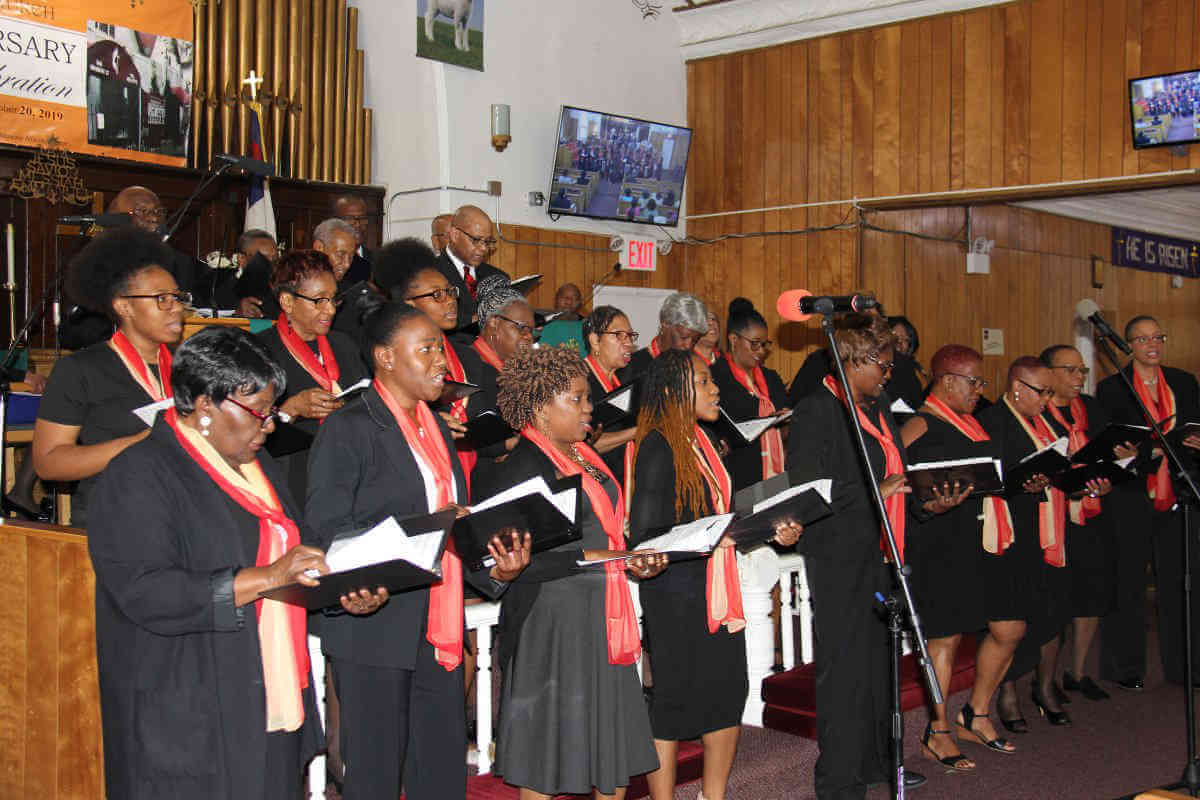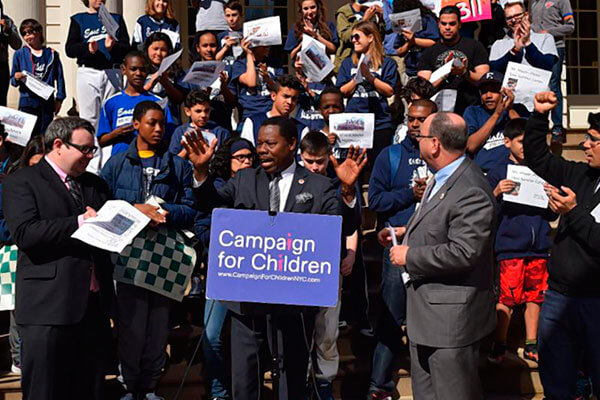With lofty singing, praying, preaching, scripture reading and dancing, among other things, Brooklyn’s Fenimore Street United Methodist Church on Sunday celebrated its 130th anniversary.
“This is a year of victory,” said the church’s African American pastor, the Rev. Dr. Maxine Nixon, in her remarks during the three-hour-long service.
“We thank God for keeping us, for blessing us,” added Dr. Nixon, who has been pastoring the church, whose membership is overwhelmingly Caribbean, at the corner of Rogers Avenue and Fenimore Street, for the last 17 years – the church’s longest-serving pastor. “God has planted us here so we can bloom.”
Most congregants at Fenimore Street United Methodist Church are nationals from Jamaica, St. Vincent and the Grenadines, and Barbados.
In delivering the sermon, based on John 3:1-3, under the topic, “Something Old, Something New,” the guest preacher, Pastor Audley Allen, the Jamaican-born Associate Pastor of the Community Worship Center of Seventh Day Adventists (SDA) in Queens, said “130 years is (are) a very long time.
“Many institutions have arrived on the horizon, but this church has survived,” he preached. “It survived because God has been with you.
“God is the protagonist of your life, and your protagonist is greater than the antagonist,” Pastor Allen said. “God is looking for a people whose life is reconstructed.
“For once, we were caterpillars,” he added, stating that believers have transformed into a process known as metamorphosis to become beautiful butterflies. “To be born again is to be changed. That’s why Paul (the Apostle) said ‘if any man is to be born again, he must be a new creation.’
“When we were born again, we will not judge each other by the color of our skin but by the content of our character,” continued Pastor Allen, using a popular line from the slain US civil right leader, the Rev. Dr. Martin Luther King, Jr.’s, iconic “I Have a Dream” speech, delivered at the Lincoln Memorial for the 1963 “March on Washington for Jobs and Freedom.”
“Hold on to your struggles, because weeping endures for a night, but joy comes in the morning — when there’ll be something new and something old,” preached Pastor Allen to a standing ovation, as congregants repeated the refrain.
Brooklyn Councilman Dr. Mathieu Eugene noted that Fenimore Street United Methodist Church has been preaching the Gospel of Jesus Christ for 130 years.
“I want to thank our sister, Rev. Dr. Maxine Nixon, for her leadership,” said Eugene, whose 40th Council District includes the church. “I truly believe in God, and I truly believe in the power of God. Continue to preach the gospel of God (Jesus Christ).”
During the morning-to-afternoon worship and celebration, congregants were treated to heart-wrenching singing by the Mass Choir, and the Men’s Chorale and Praise Teams; dance by the church’s Liturgical Dance Ministry; and saxophone renditions by Belizean Earl Henderson.
According to the church’s history, read by member Ezinne Nwosu, on Aug. 3, 1889, the Fenimore Street United Methodist Episcopal Church of Flatbush was “organized out of the first Methodist Episcopal Church, Lenox Road and Flatbush Avenues, and was incorporated on Aug. 20, 1889.”
The church was formally admitted to the New York East Conference in April 1890 and dedicated in May 1890. The first pastor was the Rev. James L. Hall, (1890 – 1894).
During the Rev. I. Hemmingways’ ministry (1951 – 1960), the membership became more integrated with many black families.
In 1968, the Rev. William J. Smartt began his pastorate as the church’s first black minister.
From 1972-74, Fenimore Street United Methodist Church “was faced with the challenge of keeping its doors open when they were given an option to merge with St. Mark’s United Methodist Church,” according to historical notes.
“With strong determination and resolve Fenimore was victorious in keeping the church in the community,” it said, adding that, during the pastorate of the Rev. Lester Baker (1974 – 1980), extensive renovations were done.
In 1978, the church building was re-dedicated and a computerized Allen Organ was purchased and dedicated to the late Dr. Donald Wright.
Under the guidance of the Rev. Neville Buchanan (1980 – 1993), “significant accomplishments were made, including the liquidation of our mortgage with a ceremonial ‘burning’”, said the church about its history.
It said the late Guyanese-born pastor, the Rev. Dr. Ivan J. Roberts (1994 – 2002), “brought more growth, physically to the church building and spiritually to the congregation.”
Rev. Roberts “guided the first ‘Rally of the Nations,’ and the proceeds were used to purchase our church van and to air condition the sanctuary and the Fellowship Hall,” the statement said.
It also said that, under Rev. Roberts’ leadership, the church purchased a six-family unit at the next door 201 Hawthorne St.
The church, first female pastor, Dr. Nixon, (2002 – present), “initiated many new ministries and Disciple Bible Study,” according the church’s history.
It said a second successful “Rally of the Nations” took place during Rev. Nixon’s ministry, with the proceeds earmarked for renovation of the Fellowship Hall and the kitchen.
“The church currently enjoys four choirs, a vibrant dance ministry and a soup kitchen that reaches out to the community,” the statement said. “To keep our congregation grounded in the word through our weekly services, a tape ministry was introduced. We burnt our mortgage for the six-family unit in September 2015.”
Retired Registered Nurse Marlene Ferguson, the Trinidadian-born chairperson of the Anniversary Committee, gave a “heartfelt thank you” to all worshippers “on this our 130th anniversary, remembering this old landmark Fenimore Street United Methodist Church.”
“As we prepared the program, we found it impossible not to reflect on our trailblazers who labored intensely on this old landmark,” she said almost at celebration’s end. “Please let us salute them with a moment of silence.
“It is our hope that, as you leave this celebration, the spirit of our trailblazers would enter your mind, soul and heart, and stir up the gift in you to go forth remembering this old landmark, as they did,” Ferguson added.




























